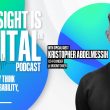In a candid and thought-provoking conversation on Thoughtful Money1, host Adam Taggart sat down with Michael Green, Chief Strategist at Simplify Asset Management, to explore what might really be propping up this market—and what could soon bring it down. Green's signature metaphor—the “giant mindless robot” of passive investing—was back, but this time with a hint of wear and tear.
Later in the show, New Harbor Financial’s John Llodra and Mike Preston join Taggart to talk about Green’s concerns as well as unpack the broader implications for investors and advisors alike.
Is the Passive Juggernaut Finally Slowing?
Green doesn’t waste any time getting to the heart of it: “There’s actually some evidence that the giant mindless robot is flattening out a little bit,” he says. “So we’re actually seeing combined flows across mutual funds and ETFs begin to flatten out and actually potentially turn down.”
That may not sound dramatic, but it could be the first real signal of a long-anticipated shift. Green breaks it down this way: when money flows into a passive fund, it pushes up market values far more than when the same amount goes into an active fund. “If you give it to a passive fund… my numbers are saying somewhere between $17 and $20 worth of market multiplier,” Green explains. For active funds? It’s more like 2x.
And here’s the kicker—passive flows don’t care about price. “You and I walk into a rug shop... the vendor says $1,000, and the passive buyer says, ‘I’ll take it.’ $1,500? ‘I’ll take it.’ $2,500? ‘Still taking it,’” Green quips. “That’s how it works.”
Aging Boomers, Mandatory Withdrawals, and a Shrinking Pool of Buyers
So what’s tightening the tap on these flows? Two major trends: a softening labor market and baby boomers starting to hit mandatory retirement withdrawal age.
“The majority of baby boomers are now starting to hit the point at which withdrawals are no longer discretionary. They’re mandatory,” Green says. Many retirees are moving out of active strategies and into low-cost passive vehicles—paradoxically feeding the robot for a little longer. But that loop, he warned, can’t go on forever.
“Roughly 70% of the assets are actually held by those over the age of 65,” Green notes. “As more and more retirements occur, that can indeed push us negative.”
Employment Numbers Are Hiding the Real Story
On the surface, unemployment looks fine. But under the hood? Not so much.
“College graduate unemployment historically has run around 1%... currently that’s running about 2.5% in aggregate. And it’s those new graduates who are really bearing the brunt of it,” says Green.
He also pointed out how gig work—like Uber driving—is masking real weakness. In states where under-25s can’t drive commercially, youth unemployment is spiking. “It’s a big deal,” he says. And while gig work fills the gap now, self-driving cars and automation could erase even that safety net.
Passive Investing: Smart or Dangerous?
Green was clear: the rise of passive investing has created a feedback loop that drives prices up regardless of value. “Passive indexing is a momentum reinforcing behavior,” he says. “It’s no surprise that factors like value have underperformed dramatically in a world that is dominated by that type of behavior.”
And if things reverse? “The more something goes up, the more these index funds have to chase that thing,” says New Harbor’s John Llodra. “But that works both ways… when prices drop, they chase downward too.”
Rising Markets, Falling Confidence
Despite markets hitting new highs, consumer sentiment is in the gutter. Green offered a sobering chart: inflation and unemployment might look fine on paper, but people still feel lousy. “COVID is truly unprecedented and unique in that it created an environment in which people sit there going, ‘Man, I’m just unhappy,’” he says. “People don’t feel purpose… they don’t feel valued.”
In Green’s view, the market’s current optimism is being driven by one thing: automated flows. “Nowhere in that equation of ‘I currently have a job, I give that money to Vanguard, Vanguard buys stocks’… is there an observation about unemployment except mine,” he says.
Rethink Risk: What Should Advisors and Investors Do?
When asked what he’s doing with his own portfolio, Green doesn’t hesitate: “Invest for what you need, not what your neighbor wants,” he advises. For his part, he’s leaning into fixed income and structured credit—particularly Simplify’s High Yield ETF.
“I think high quality fixed income or credit-enhanced fixed income… is a fantastic place to put your pool of capital right now,” he says.
Mike Preston echoes the sentiment. “It’s really important to have humility,” he says. “This market works until it doesn’t. And if it starts going the other way, it could move fast.”
Final Word: Passive Populations, Passive Capital
Green closed with a warning—not just about markets, but about society.
“We have meaningless jobs and very little sense of purpose,” he says. “That’s a farm. That’s not a meaningful human existence.”
In his eyes, we’ve become “domesticated”—cows, grazing while passive capital flows drive up valuations with no regard for reality. But if flows reverse? “Markets will be reminded that passivity comes with a price.”
Takeaways for Advisors & Investors
- Passive flows are powerful—but not invincible: When they slow, the downside can be just as dramatic as the upside.
- Demographics are destiny: Baby boomer withdrawals will grow and could eventually turn net flows negative.
- Headline employment is misleading: The gig economy and new graduate underemployment point to deeper weakness.
- Price chasers rise, and they fall: Passive funds buy more as prices go up—and sell more as they go down.
- Rethink what “success” looks like: Investors should anchor on goals, not benchmarks.
- Fixed income is having a moment: High real yields could be a lifeline for investors chasing stability.
As Green puts it: “You don’t get to go back to 2002 and buy Amazon at one and a half times sales. This is today. And you have to ask yourself: What does the next decade look like?”
Footnotes:
1 Thoughtful Money®, Adam Taggart | "Precursor To Mayhem? All-Important Passive Capital Flows Are Faltering | Mike Green." YouTube, 6 July 2025

















